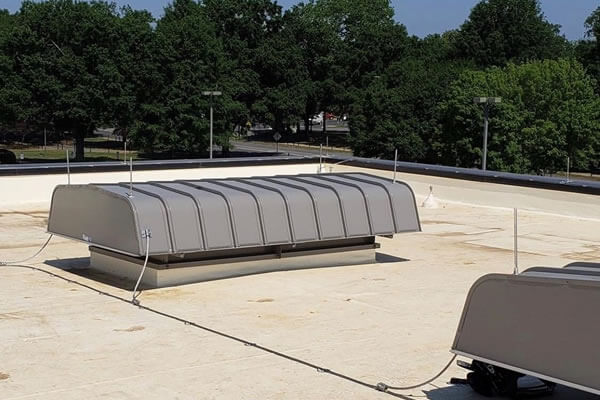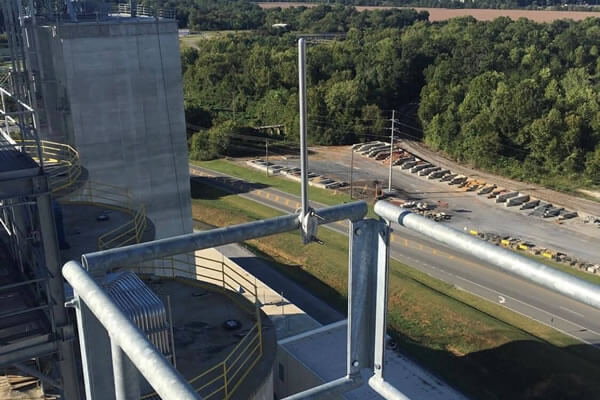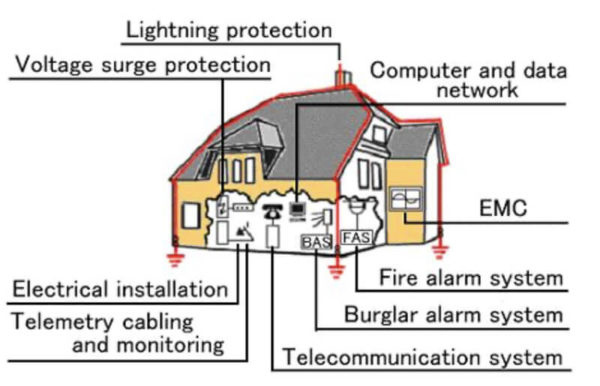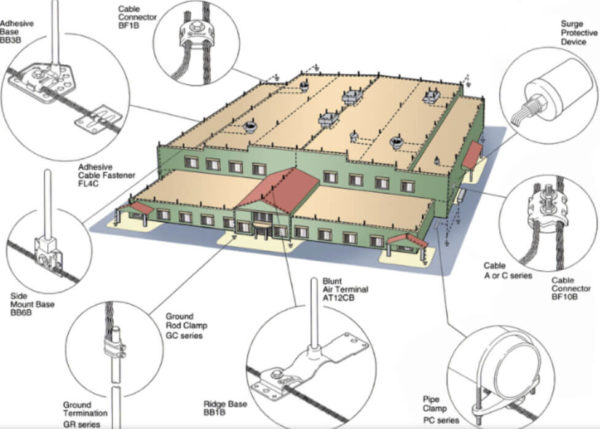Lightning Protection System Design
Florida based lightning protection system company Coastal Lightning Rods designs lightning protection system in accordance with the current standards and specifications. More importantly, our lightning protection system design can ensure you have the right infrastructure in place to protect your property and equipment, your people, and your business. We have a proven record of designing lightning protection systems that protect structural damage to buildings, and failure of internal systems and equipment. The proper implementation of a lightning protection system includes knowledge, craftsmanship, and experience.
Lightning protection design is all about protecting your valuable assets from the dangers of lightning strikes. Benjamin Franklin came up with the first lightning safety device in 1752, called the lightning rod, and it’s still a great way to protect your property from lightning strikes. Other modern lightning protection systems, like the Dissipation Array System from LEC also offer lightning safety. If you’re thinking about designing a lightning unit, it’s a good idea to get in touch with a professional lightning protection design team.
Failure to design a proper lightning system makes it ineffective. A lightning protection system is designed to create a direct path for lightning charge to the ground. The system acts at the point where the lightning strikes keeping the structure of building and it’s occupants safe. The experienced engineers at Coastal Lightning Rods will create a perfect design that will protect your property from lightning.
Here are some types of lightning protection systems that can be designed:
Concealed: a fully concealed system can only be installed during the building of a new house. The cable and connections are made in the walls and attic. The only thing visible are the lightning rods.
Partially concealed: a partially concealed system can sometimes be installed on a existing house that has enough access and attic space to run the cable. For this type of installation the down conductors will be exposed from the soffit to the ground.
Exposed: a fully exposed system will have cable and lightning rods on the roof. The cable will be ran behind the ridges and hips to be hidden as much as possible. The down conductors can be ran behind gutter downspouts for less visibility.
How Does Lightning Protection Work?
The main purpose for a lightning protection system is to route the electrical energy from a lightning strike to a less destructive path to ground, rather than letting it travel through the building’s structure, electrical wiring, pipes where it would create a havoc.
Lightning rods or air terminals are the topmost element of a lightning protection system installation where the initial contact between the lightning strike and system occurs. Therefore the lightning rods are strategically installed on the roof, chimneys or other elevated areas. Highly conductive copper and aluminum materials are used in a lightning protection system that provides a low resistance path to safely ground lightning’s dangerous electricity. The lightning strike is intercepted and directed to ground without impacting the structure, occupants or contents of the property.
What does a lightning protection system consist of?
A lightning protection system includes a network of air terminals, bonding conductors, and ground electrodes designed to provide a low impedance path to ground for potential strikes.
The dissipation of a lightning strike requires correct system design, installation in accordance with UL 96A, NFPA 780 and all listed components correctly installed and connected to earth. The installation must be designed to protect the entire structure not just a small portion or section of the structure.
The main attribute common to all lightning rods is that they are all made of conductive materials, such as copper and aluminum. Copper and its alloys are the most common materials used in lightning protection.
A well-designed, properly installed Lightning protection systems mitigates the fire hazard which lightning strikes pose to structures. A lightning protection system provides a low-impedance path for the lightning current to lessen the heating effect of current flowing through flammable structural materials. If lightning travels through porous and water-saturated materials, these materials may literally explode if their water content is flashed to steam by heat produced from the high current. This is why trees are often shattered by lightning strikes.
Lightning Protection System Design FAQs
Do you have questions about lightning protection system design? Do you need more information about lightning protection system design?
What factors do you consider for Lightning Protection System Design?
The general considerations to examine are the level of risk that lightning provides to employees, equipment, structural damage, and the problems that result from a lightning-caused failure. Although not a precise science, assessing these aspects requires judgment in weighing dangers, economics, and aesthetics.
What is a lightning protection system design made of?
A lightning protection system is made up of five important components. A roof network, down conductors, equipotential bonding, a grounding system, and surge suppression devices on incoming power and communication cables will be included in every lightning protection system.


29 Years in Business. Home Advisor Screened and Approved.
Coastal Lightning Rods of Florida, provides a full range of lightning protection services including:
- Risk Assessment – We perform a risk assessments before we install the lightning protection system.
- Lightning Protection System Design – Each property is unique and has a different size and shape. We design a lightning protection system that meets all standards.
- Lightning Protection System Installation – We install the designed lightning protection system and make sure it complies to all standards and codes of practice.
- Lightning Rod Installation – Lightning rods are usually placed at the highest points of a building or structure to maximize their effectiveness in attracting lightning strikes. This could include roof peaks, chimneys, or tall masts.
- Grounding – Along with lightning rods, a grounding system consisting of grounding rods buried deep into the ground is essential. This system provides a safe path for the electrical current from a lightning strike to dissipate harmlessly into the earth.
- Retrofit Existing Lightning Protection System: Retrofitting an existing lightning protection system involves making modifications or additions to enhance its effectiveness or meet updated safety standards.
- Tests & Inspections of Lightning Protection Systems – We offer Annual testing of existing lightning protection systems.
- Lightning Protection System Maintenance & Repair – Over time your lightning protection system may damage. We provide repair service in the event of damage.



